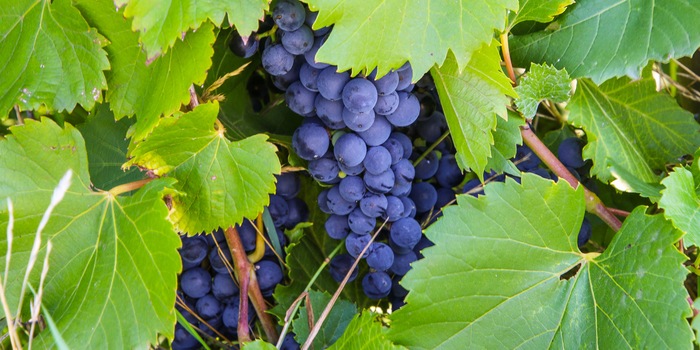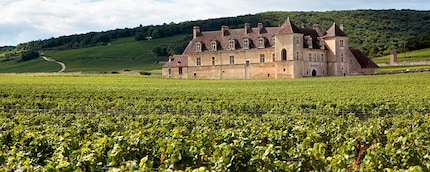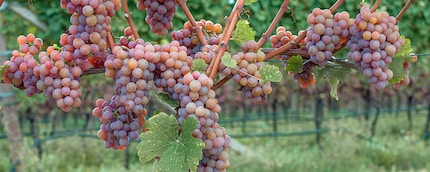

Wine guide: overview of the most important grape varieties
There are around 10,000 grape varieties in the world. Around a quarter of these are approved for wine production. The majority of these varieties play only a minor role in viticulture and are often only significant in small regions. Below is a brief portrait of the most important and best-known grape varieties and where they are grown.
The most important red grape varieties
Cabernet sauvignon
Today, high-quality wines made from this grape variety are produced in Chile, Argentina, Australia and California. But this grape variety owes its excellent reputation to the wines of the Médoc, a region in the south of France where it predominates. Its grapes are small, and it is often used in blends with Merlot, and ripens late. Depending on the region, the grape develops dark, fruity wines rich in tannin and with very floral aromas. With age, a roasted aroma is added.

See all wines made with cabernet sauvignon
Grenache
In Rioja, Grenache is one of the most important red grape varieties. It is frequently used in blends with tempranillo to produce top-of-the-range red wines. Its modest pigmentation makes it ideal for making rosé wines. The sweet grape delivers a red wine rich in character and powerful, but also light rosés.
See all wines made with grenache
Merlot
Meanwhile, this grape, perfect for blending, is grown on every continent. Merlot especially works wonders with Cabernet Sauvignon. Many Bordeaux wines, for example, contain some Merlot. Thanks to its medium alcohol content, the grape produces a silky, fleshy wine. Single-vineyard wines made from Merlot are rare and therefore quite expensive.
See all wines made with merlot
Nebbiolo
The grapes of Italy's Piedmont region deliver wines rich in tannin and with plenty of slow-ripening character. Nebbiolo is one of the slowest wines to ripen, but it is also one of the wines that retains its quality the longest. The nebbiolo grape is also used to produce Barolo, one of Italy's most renowned wines.
See all wines made with nebbiolo
Pinot noir
Difficult to grow, pinot noir is one of the best grape varieties in the world. The resulting wine is more versatile, sweet, balanced and full-bodied than the famous Cabernet. In Champagne, the variety is vinified without skins and is the main ingredient in champagne. The best red wines with these grapes come from Burgundy. Here, as a rule, it is grown as an expensive single varietal of very high quality.
See all wines made with pinot noir

Sangiovese
Following its cheap mass production in the 1970s, the grape had a bad reputation. However, following an increase in quality over the last few decades, this has changed. The grape is now even the basic ingredient of Italy's most famous wine: Chianti. Nowadays, Chianti has become very good and expensive. The taste of these wines is round and full, with aromas of cherry and violet. Apart from the Chianti between Florence and Siena, this grape variety is also present in the grand crus of southern Tuscany: in Brunello di Montalcino and Vino Nobile di Montpulciano.
See all wines made with sangiovese
Syrah or shiraz
Although not universally acclaimed, it is with this vigorous grape that some of the best red wines are produced. It produces dark, resistant wines that are rich in tannin. Originally from the south of France, this grape variety is now also part of the composition of expensive and trendy wines in Australia. In France, it is often used in blends with other varieties. In Australia, on the other hand, it is grown as a single variety to produce a high-end wine with a high alcohol content.
The tempranillo
The base variety for the famous Rioja is, over there, considered the best red grape variety. The long, dark grapes need a lot of care. They produce a fruity wine with pleasant acidity. Depending on the ageing, aromas of bitter chocolate, tobacco, spices or liquorice are also present.
See all wines made with tempranillo
Zinfandel
Californian vineyards are full of this excellent grape variety. The wine drawn can already be drunk very early and young. The wine can just as easily be stored for decades like good Bordeaux. It also has a similar taste. It is the genetic equivalent of primitivo, a grape variety grown in Puglia - a region of southern Italy.
See all wines made with zinfandel
The most important white grape varieties
Chardonnay
Chardonnay is a noble grape variety that is among the most highly regarded white grape varieties. In the world. As such, it is ideal as a grape variety for white champagnes or white Burgundies. It is easy to grow and not too demanding in terms of climate. It is also very popular on the other side of the Atlantic. Today, it is one of the most important white grape varieties. Aged in oak barrels, the wine develops accents of toasted bread and toasted wood. The grape is versatile, making it possible to create different flavours depending on the vineyard.
See all wines made with chardonnay
Gewurztraminer
This grape is becoming increasingly widespread around the world, but it is found most abundantly in Alsace and Germany. Gewurztraminer produces very spicy wines. The flavour is highly aromatic, reminiscent of grapefruit, lychee, bitter orange and marzipan, with notes of rose on the nose. The grape is very demanding when it comes to climate, location and soil characteristics. So, in the event of disease, expect greater crop losses than with other grape varieties.
See all wines made with gewurztraminer

Muscat
Wines made from this grape variety all exude a very intense muscat scent. In ancient times, the Romans and Greeks were already making top-of-the-range wines from this grape. Single-varietal white wines are fine and fruity. The best-known variant is Muscat d'Alsace. Nowadays, this grape variety is often enriched with alcohol - to create liqueurs, for example - or transformed into sweet, richly flavoured wines.
See all wines made with muscat
Riesling
This German classic has long been underrated. However, in recent years it has also become very popular in other countries. A wine made with Riesling has less alcohol than a fuller-bodied Chardonnay, for example. The refreshing taste is fruity and tangy. With age, the wine develops petroleum accents. From pale green to golden yellow, many shades of colour come into play. German Riesling wines in particular enjoy a high profile and are therefore expensive.
See all wines made with riesling
Sauvignon blanc
In France, this white grape variety is one of the noblest. Directly after Chardonnay, it is the most important in the world. Its main characteristics are an intense nose, "green" aromas and a full-bodied palate. In Bordeaux, winemakers blend this variety with Semillon to produce a wine that is harsh and dry, but also sweet and flavoursome.
See all wines made with sauvignon blanc
Back to main overview: [[marketingpage:6817]]
Friends, family, cats and good wine are my lifeblood.
Interesting facts about products, behind-the-scenes looks at manufacturers and deep-dives on interesting people.
Show all










